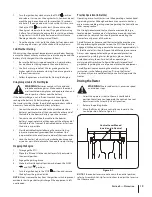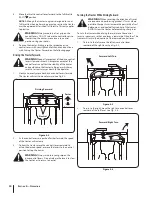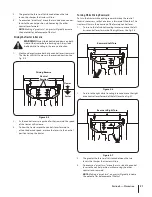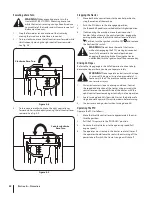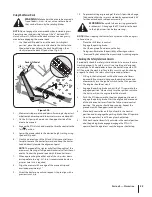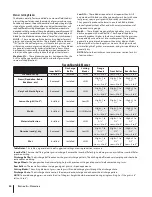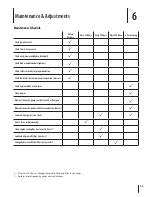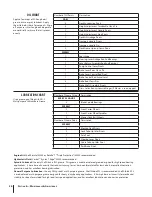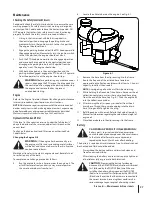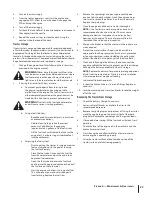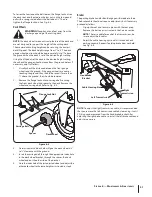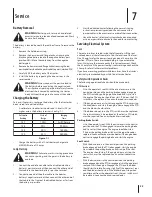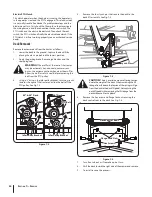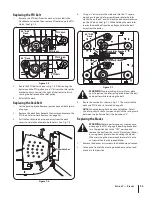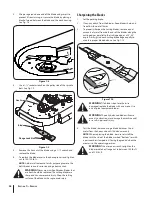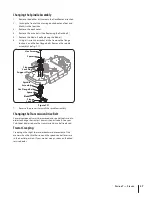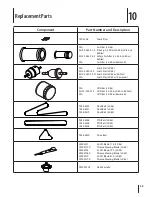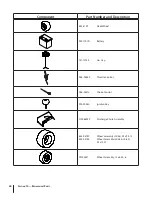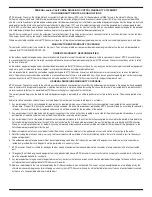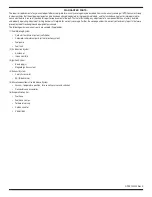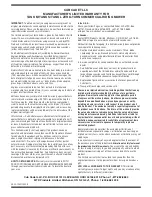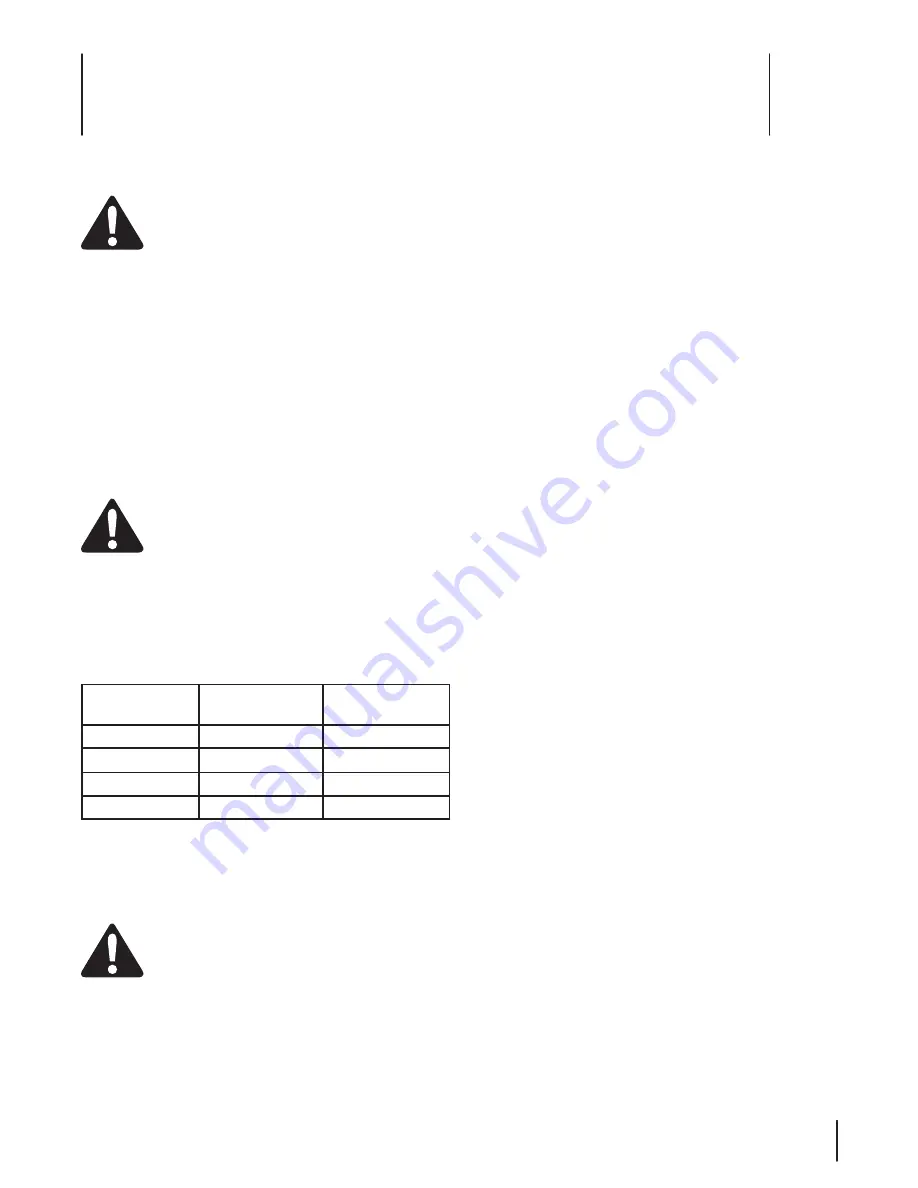
Service
7
33
Battery Removal
WARNING!
Battery posts, terminals and related
accessories contain lead and lead compounds. Wash
hands after handling.
The battery is located beneath the seat box frame. To remove the
battery:
1.
Remove the hold down strap.
2.
Remove the hex screw and flange lock nut securing the
black negative battery lead to the negative battery post
(marked NEG). Move the cable away from the negative
battery post.
3.
Remove the hex screw and flange lick nut securing the red
positive battery lead to the positive battery post (marked POS).
4.
Carefully lift the battery out of the tractor.
5.
Install the battery by repeating the above steps in the
reverse order.
WARNING!
Always connect the positive lead to
the battery before connecting the negative lead.
This will prevent sparking or possible injury from an
electrical short caused by contacting the tractor
body with tools being used to connect the cables.
Charging the Battery
Test and, if necessary, recharge the battery after the tractor has
been stored for a period of time.
•
A voltmeter or load tester should read 12.6 volts (DC) or
higher across the battery terminals. See Fig. 7-1.
•
Charge the battery with a 12-volt battery charger at a
MAXIMUM rate of 10 amps.
Jump Starting
WARNING!:
Failure to use this starting procedure
can cause sparking, and the gases in the battery to
explode.
1.
Connect the end of one cable to the disabled machine
battery’s positive terminal; then connect the other end of
that cable to the booster battery’s positive terminal.
2.
Connect one end of the other cable to the booster
battery’s negative terminal; then connect the other end of
that cable to the frame of the disabled tractor, as far from
the battery as possible.
Voltmeter
Reading
State of
Charge
Charging
Time
12.7
100%
Full Charge
12.4
75%
90 Min.
12.2
50%
180 Min.
12.0
25%
280 Min.
3.
Start the disabled tractor following the normal starting
instructions previously provided; then disconnect the
jumper cables in the exact reverse order of their connection.
4.
Have the tractor’s electrical system checked and repaired
as soon as possible to eliminate the need for jump starting.
Servicing Electrical System
Fuse
There are two fuses located inside the left console. Lift the seat
and look down at the left console to find the location of the fuses.
One 30 amp fuse for the power steering and one 25 amp fuse the
ignition, PTO, etc. These are standard plug-in type automotive
fuses. Always use the same capacity fuse for replacement. Check
the 30 amp fuse if the power steering is not working and check the
20 amp fuse for all other electrical problems.
If you have a recurring problem with blown fuses, have the tractor’s
electrical system checked by your Cub Cadet Service Dealer.
Safety Switch Operation Checks
The following operational checks should be made daily:
PTO Switch
1.
Sit in the operator’s seat. With the drive levers are in the
neutral position and the parking brake engaged, engage
the PTO switch by pulling up on the knob and try to start
the engine. The engine should not start. If it does, the PTO
switch must be replaced. See an authorized service dealer.
2.
If the engine does not start, disengage the PTO by pressing
the knob down and start the engine. Now enagage the PTO
and the blades should rotate.
3.
If the blades do not turn, the PTO switch must be replaced,
the seat switch must be replaced or the electric PTO clutch
must be repaired. See an authorized service dealer.
Parking Brake Switch
•
Sit in the operator’s seat. With the drive levers in the neutral
position and the PTO disengaged, release the parking brake
and try to start the engine. The engine should not start.
•
If it does, the parking brake switch must be repositioned or
replaced. See an authorized service dealer. If the engine does
not start, engage the parking brake and start the engine.
Seat Switch
•
With the drive levers in the neutral position, the parking
brake engaged and the PTO disengaged, start the engine.
Now release the parking brake, and raise up off the seat.
The engine should stop. If the engine does not stop, the
seat switch must be replaced. See an authorized service
dealer.
•
With the drive levers in the neutral position, the parking
brake engaged and the PTO disengaged, sit in the operator’s
seat and start the engine. Enagage the PTO and the blades
should start to rotate. Raise up slightly off the operator’s seat
and the blades should stop. If the blades do not stop when
you dismount from the operator’s seat, the seat switch must
be replaced. See an authorized service dealer.
Figure 7-1

